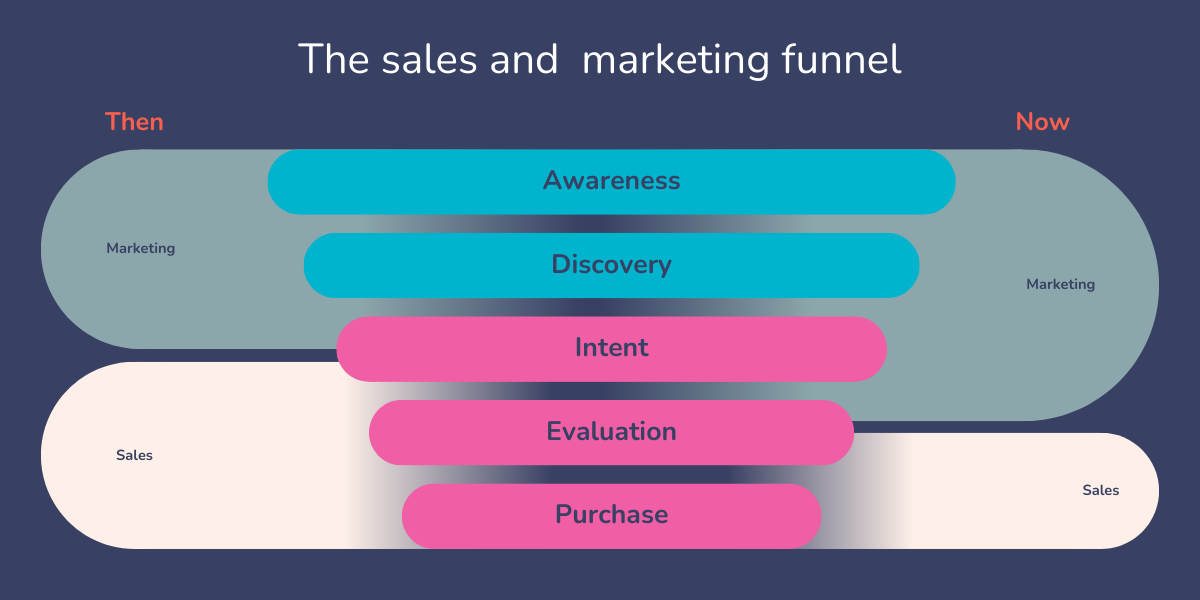What is effective lead nurturing?

Increasingly, B2B customers spend a while in the consideration phase – weighing up options, looking for solutions that suit, and seeking partners who sing from the same song sheet.
Many leads who enter your funnel are nowhere near converting. Yet.
In this guide, we explore the critical role that content marketing plays in nurturing leads and helping ease them through the sales funnel.
But first, let’s define lead nurturing to ensure we’re on the same page.
What is lead nurturing?
Lead nurturing is a strategic way to develop relationships with leads at every stage of the sales funnel and throughout their sales journey.
It is not about automated email sequences, although these are part of a much larger communication story.
Lead nurturing relies on a multi-channel approach to marketing and sales communication.
This includes:
- Using carefully targeted content to engage prospective buyers
- Using thought leadership to build trust
- Exploring solutions to answer objections
- Tentatively proposes rather than boisterously asserts
In short, lead nurturing uses content to open discussions and create a space for dialogue. Consider this:
- According to Marketo, at least 50% of the leads in any sales funnel are nowhere near being ready to buy
- Forrester has found that there is a 20% increase in sales opportunities from nurtured leads
- It also found that those who excel at lead nurturing will generate 50% more sales at a 33% reduction in cost per sale
- What’s more, The Annuitas Group revealed that nurtured leads make 47% larger purchases than their neglected counterparts
Another reason you need to nurture leads is that they may enter your sales funnel very early on, but if you’re not actively nurturing them, they may well languish in thin air at the top of the funnel.
Sales funnels are getting longer and longer as B2B buyers carry out their own independent research online. The role of sales hand-holding is pushed further and further down the funnel.
Research from Aberdeen tells us that prospects receive, on average, ten marketing ‘touches’ from the time they enter the funnel to the time they become a customer.
Let’s see how you can make each touch really count.
How to nurture leads: 6 channels for success
Turning a prospective buyer into a successful lead isn’t easy. That’s why you need to create consistent messaging across these six channels as part of your lead nurturing campaigns:
1. Email
Yes, email is the most effective way to deliver targeted content to a specific lead, but to generate the best results, it must be trusted, relevant, personalised, and conversational.
Try using email to invite carefully chosen leads to attend an industry webinar exploring the latest trends or discussion points.
Of course, you’ll mail the presentation and details of the discussion to those who registered or attended. But why stop there? Make sure you also send a precis of the key points to all those who didn’t attend, alongside an invite to the next event.
Not sure how to generate more leads from webinars? Let us help.
2. On your website
Develop targeted content and landing pages aimed at each buying stage for your unique buyer personas. And, most importantly of all, consider this comment from a frustrated CMO:
“The sales team never used 60% of the content created by the marketing department. I also found that 90% of the content we were creating was product-specific, even though most of our audience was in an early stage of the buying journey and asking non-product specific questions.”
Michael Brenner, Head of Strategy at Newscred, on his experience at SAP
Your website is there to sell a service and a product. But that’s just a part of the picture. It’s also there to engage your target audience and nurture those at the earliest stages of the buying journey by joining in a conversation or sparking thought and debate.
3. On social media
Focus your efforts by considering where your prospects are and the types of content they engage best with.
One often overlooked tactic by B2B marketers is to use paid social media advertising to ensure that the stories they are telling, events they are promoting, and content they are sharing gain a much wider reach than those who happen to follow their account.
Paid social gives you greater control over who can see your content. You can opt to target similar audiences to those who have worked for you in the past or target a new group of prospects by demographics, interests, geography, job roles, etc.
4. By remarketing ads
Remarketing, whether via social networks, search, or display, allows you to continue conversations with those who have shown interest.
5. By lead scoring and marketing automation
It’s essential to know how your content marketing is progressing, and lead scoring is a way to pinpoint where each lead is in your sales funnel.
It’s based on agreeing to a score for certain actions or known characteristics for those in your funnel. These scores are used to identify when and how to communicate most effectively with each lead by using timely and relevant communication.
Discover the complete lead scoring guide to ensure your strategy is up to scratch.
Marketing automation is how you can match your content and channels to the stage each lead is at.
Even the most talented salesperson could build trust and maintain rapport with, at best, 50 leads. Marketing automation is a tech solution that uses lead scoring to streamline and automate multi-channel marketing.
6. On the phone
Our final point is to emphasise the importance of timely contact from the sales team.
Effective lead nurturing is an automated, multi-channel response to the elongated B2B buying journey. However, none of this is to say that the personalised sales call or sales mail is no longer relevant.
It’s simply to emphasise that these are often no longer your first port of call.
The important thing here is to identify when to hand things over to sales or involve them in the nurturing process.
And that’s a decision that lead scoring can make easier.
Five golden rules of successful lead nurturing campaigns
1. Align your sales and marketing teams
A common misunderstanding is to view lead nurturing as the preserve of the marketing department.
How very, very wrong!
You have to nurture leads throughout the entire sales journey. This means that sales must have an active stake in managing the process before the handover. After the handover, marketing can still greatly influence the nurturing that takes place.
Sales and marketing alignment is essential for this to work, but it is tougher to achieve than it sounds.
Sales and marketing must share the same view of – and share common goals at – every step of the customer journey. That’s throughout the sales cycle and in all of the…
- Key metrics used to define this cycle
- Definitions of the ideal customers that inform it
- Understanding of how buying decisions are reached during it
- Perceptions of the competitive marketplace that it takes place in
Lead nurturing without sales involvement or enough marketing input toward the top of the funnel is like trying to dance with two left feet. It’s unnecessarily tricky, a little bit embarrassing, and never ends how you want it to.
Read our guide to buyer enablement to understand how the right content can help move prospects through the sale funnel.
2. Identify and address every stage of the sales cycle
Now you are neatly aligned across sales and marketing; it’s time to start gaining benefits from all your hard work. Together, you can piece together a complete view of your customer journey.
At its simplest, customer journeys move from a need for generalised information toward tailored and more specific content.
Use buyer personas to determine exactly what type of information would be most useful to each of your audiences at different touchpoints.
And voila; you have effectively created a lead nurturing strategy.
3. Automate to personalise and segment
Automation is theoretically not essential for lead nurturing, but theory alone has never brought in a sale.
In practice, successful lead nurturing is delivered by marketing automation solutions and CRMs.
These not only make things easier – they also make things smarter and more effective. By linking your CRM and automation tools, you also create greater transparency and alignment between marketing and sales.
- Automated distribution brings productivity gains and ensures prospects and touchpoints do not fall between the cracks of your busy daily schedule.
- Automation also enables greater personalisation and increased contextual relevance of communication.
- As the lead generation data you build up becomes more comprehensive, your campaigns can use smarter ways to segment prospects, thus increasing the relevancy of the content you share.
4. Keep on track with tracking
Data helps you understand your customers – it’s nice like that. But data should also help you understand the success of your marketing campaigns, including your lead nurturing strategy.
Hint: without a foundation of metrics and KPIs, your data will never ground your understanding. Get these in place, or risk floating through a sea of unfathomable figures.
5. Optimise
Let’s keep the maths simple as we sum up optimisation.
Lead nurturing: Customer journey mapping + Content marketing = More useful data
Optimisation: More and more useful data + Understanding = Effective action
That customer journey is just the start of the road to optimisation: use the data you gain from addressing it to loop back and improve your understanding and response to it.
Here are some examples of that virtuous loop in practice:
- Profiling leads progressively: Smart forms can collect a bare minimum of information as an easy entry point for prospects. But, as your prospect interacts more with your content, you automatically collect more information about them to further nurture and qualify them.
- Landing page optimisation and segmentation: Test CTAs, button design, length, imagery, headlines, and forms. Don’t just go with a winner; review to see if a ‘type’ of prospect prefers A over B. Then, segment (and test again).
A/B testing of email campaigns: Why let landing pages have all the split testing? Apply this to your emails, too.
The importance of aligning sales and marketing teams
Sales and marketing used to sit and work separately. Marketing generated leads for sales, and then a sales development team would qualify these before they were passed on to the sales team for conversion.
Things have changed now, and this is because buyer behaviour has changed drastically.
In many ways, the buyer is now in control and driving the relationship. They research independently online, review socially, and share or gather information across digital networks. What’s more, they are mobile and empowered with easy access to information, influencers, and peers.
This means that the sales funnel has changed, too.
Now, sales and marketing must be continuously integrated and aligned throughout a lead and customer’s lifecycle. There are no longer those clear-cut handover points.
In fact, the new sales funnel looks like this:

What does this mean in practice?
- Marketing needs to understand more about sales
- Sales need to understand more about marketing
- Both teams need to play catch-up to understand precisely where their customers are
All of this means that marketing and sales need to work together to equip sales with visibility online. This is largely what the turn to social selling has been about. It is an area where direct engagement from sales and coordinated content campaigns can help centre organisations where their buyers are.
We must also point out that the terms of engagement have changed. It’s no longer about hard sales but facilitating and joining in conversation to help, inform and educate.
After all, this is the age of the customer, not the seller.
The most successful teams will be aware of this fact and agile enough to explore their options, updating b2b lead nurturing strategies to suit this new phase of sales.
Summarised: The five golden rules of lead nurturing tactics
Lead nurturing is all about good communication. This enables you to:
- Effectively align sales and marketing teams
- Address the potential customers’ needs at every stage of your lead nurturing efforts
- Stringently test and analyse data to personalise and target content, addressing pain points and answering key questions
- Strengthen relations between sales and marketing teams
Head to our resource hub and blog for more insights into developing your lead nurturing program.
Here, you’ll find vital information on upgrading your lead generation and nurturing processes with content marketing, our B2B email and content marketing masterclass webinar, and other helpful guides to maximise your team’s efforts.
If you’re ready to take your lead nurturing to new heights, book a demo and discover how our experts can supercharge your B2B lead generation, email marketing and multi-channel marketing efforts.
We’re Sopro
And since 2015, we’ve been busy transforming how companies generate new business with prospecting and lead generation.
Our team of 300 global experts combine genuine human insight with in-house tech and live lead generation data to design multi-channel campaigns that help you sell more.
We engage your ideal prospects with personalised outreach, act on buyer intent signals, and connect them with you when they’re ready to talk sales.
At Sopro, we’re a B2B lead generation agency with a difference. We don’t just give you logins or a list of leads—our expert teams work with you to build sustainable campaigns set up for long-term success.
Looking for a lead generation agency for telecommunications companies or a lead generation agency for design services? Or maybe you’re after a lead generation agency for staffing and recruitment companies. Look no further than Sopro. We’ll develop messaging that resonates with the decision-makers you need to sway.
Or, if you’re looking for more guidance, take a look at our blog. Our experts have compiled guides on everything you need to know about lead generation on prospecting, including information on using referral marketing to generate better leads, how to overcome sales objections, how to get leads from Google Ads, and lead rates by company size.




Share